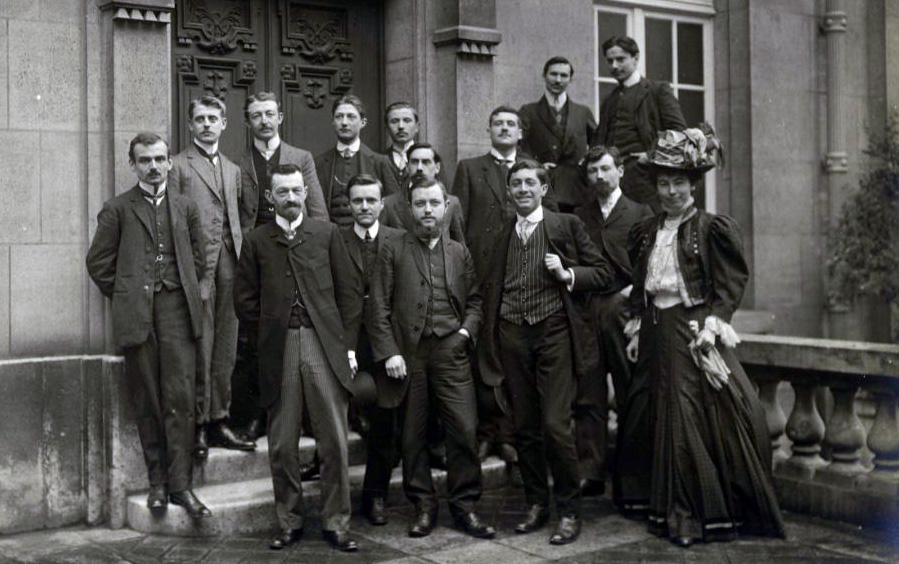Frise chronologique
Key dates in the history of the École nationale des chartes - PSL.
1681
Publication of De Re Diplomatica by Jean Mabillon
The École des Chartes is traditionally regarded as a legacy of the Maurist Benedictine monks of Saint-Germain-des-Prés, the Paris abbey where Jean Mabillon (1632-1707) developed his De re diplomatica. This vast practical and theoretical work sets out the rules of the historical criticism of charters. Marc Bloch regarded the year of its publication as ‘a great milestone in the history of the human mind’.

Jean Mabillon's De re diplomatica© Bibliothèque de Reims
1807
A ‘Novitiate’ of Young Scholars
Baron de Gérando, General Secretary of the Ministère de l’intérieur suggested Napoleon I create a ‘special school of history’ based in Paris to educate students in scholarly disciplines, starting with bibliography. Approved by the emperor, who considered that ‘How history is read is, in itself, a true science’, the project would not be implemented until the Restoration.

Portrait of Joseph-Marie de Gérando (1772-1842) © Bibliothèque de l'Institut de France
1821
The Founding Ordinance
The Revolution's dramatic impact on the documentation inherited from the Ancien Régime, with the creation of conservation institutions such as the Archives nationales and the Archives départementales, highlighted the need to pass on the scholarly disciplines cultivated in the past. Established by the royal decree of 22 February 1821 and housed in the Bibliothèque Royale, the new School harked back to medieval charters but was also in keeping with a regime governed by the Constitutional Charter of 4 June 1814, considered the guarantor of freedoms.

Ordinance of 22 February 1821 creating the École des chartes
1829
Institution of the Title of Palaeographer Archivist
An ordinance of 11 November 1829 instituted a three-year curriculum, beginning with one year of education in the fundamentals of palaeography, followed by two years devoted to studying the ‘critical science of written monuments’, leading to final exams. Students who pass the examinations are awarded the title of ‘Archiviste paléographe’; since 1833, their names has been read out at the official opening session of the Académie des inscriptions et belles-lettres.

‘Archiviste paléographe’ diploma (1870)
1834
Creation of the ‘Comité des travaux historiques et scientifiques’ (Committee for historical and scientific research)
François Guizot, Minister of Public Education since October 1832, organised historical science to encourage research and the publication of sources on French history. On 18 July 1834, he founded the ‘Comité de l'histoire de France’ (Committee for French history), which would become the ‘Comité des travaux historiques et scientifiques’ in 1881. The school's teachers and former students, sometimes called ‘Guizotins’, were active members from the outset.

Photograph of François Guizot by Félix Nadar (approx. 1857)
1839
Creation of the Bibliothèque de l'École des chartes
In 1839, former students founded the Société de l'École des chartes as well as a journal the same year to disseminate their scholarly work. The Bibliothèque de l'École des Chartes is one of France's oldest scholarly journals. It is internationally renowned for its articles on history and philology.

Issues of the Bibliothèque de l'École des chartes
1846
The Second Birth of the École
An ordinance of 31 December 1846 established the École's modern structure: multidisciplinary teaching that highlighted the diversity of historical sources, its director, premises, and library, and the requirement for students to submit a ‘public paper on their chosen theme’ to obtain their diploma. This was the origin of the thesis, for which an abstract was then published in Positionsdes thèses

For the start of the new school year in 1847, the first under the new ordinance of 1846, a poster was published giving details of course schedules and names of teachers and tutors.
1897
Moving to the Sorbonne
The École des chartes, housed at the Archives Nationales since 1847, moved to the Nouvelle Sorbonne in the autumn of 1897. There, it occupied the premises originally intended for the Faculty of Theology, with its own entrance. This real estate move confirmed the École’s outstanding position in French higher education.

Entrance to the École nationale des chartes at the Sorbonne © cl. Myr Muratet
1899
Involvement in the Dreyfus Affair
The Dreyfus Affair, that broke out in 1894, was an opportunity for chartists to use their science to serve a cause beyond scholarly circles. Émile Zola enlisted the help of the École’s director, Paul Meyer, and professors, Arthur Giry and Auguste Molinier, to contribute their palaeographical expertise to exonerate Captain Dreyfus. Another professor, Paul Viollet, played an active role in creating the Ligue des Droits de l'Homme (Human Rights League) in 1898 and co-drafted its articles of association.

Illustrated supplement of the Petit Journal, 13 January 1895
1906
The First Coeducational Grande École
No text stipulated that students at the École des chartes had to be exclusively male. In 1906, the daughter of a polytechnician, Geneviève Aclocque, passed the entrance exam, a first hailed by the newspapers at the time: ‘The public can no longer believe in the inferiority of the female sex’. After the Great War, the feminisation rate accelerated: by 1924, parity had been reached and was soon surpassed in the 1930s.

Group photo of second-year students, with Geneviève Aclocque (Sorbonne Main Courtyard, 1908)
1914-1918
The Toll of the Great War
307 archivists, palaeographers and students of the École were mobilised during the First World War. 51 of them were killed in action, a rate (16%) in keeping with the national average. The demographic effects of the bloodletting affected the youngest promotions and were severely felt two or three decades later.

Plaque commemorating the archivists, palaeographers and students of the École who died for France 1914-1918
1919
Introduction of Preparatory Classes in Lycées (secondary school)
Following the literary preparatory classes created at the beginning of the 20th century, the first specific class for the competitive examination for the École des Chartes was opened in 1919, first at the Lycée Louis-le-Grand and then at the Lycée Henri-IV. A second preparation class was opened in 1964 at the Lycée Pierre-de-Fermat in Toulouse and a third in 1986 at the Lycée Fustel-de-Coulanges in Strasbourg. The 1991 entrance examination reform, which introduced two streams for admission to the École des chartes, further increased the number of lycées offering preparation classes.

Cloister of the Lycée Henri IV in Paris, at the foot of the Clovis Tower
1950
Technical Internship
In response to a long-standing request from students and the profession, the French Archives Department introduced an end-of-studies technical course to prepare graduates for the practical aspects of the archival profession. In 1951, this course became the ‘stage technique international d'archives’ (international archival technical internship), which brought young palaeographers into contact with their future colleagues from various backgrounds. Since 1963, future librarians have received professional training at the École nationale supérieure de Bibliothécaires (which became ENSSIB in 1992).

Archives Nationales (Paris). Large depots, ‘Armoire de fer’ hall
1968
The University Crisis
Like other institutions, the École des chartes was affected by the May 68 crisis. Students criticised the curriculum as ill-suited to the profession's challenges and the lack of links with universities. The end of the crisis sounded the death knell of a single training programme for all students: it led to the creation of new chairs, the introduction of optional courses, a focus on contemporary sources and issues, and closer links with university curricula.

‘For the first time since 1848, we're dusting things off here’: Place de la Sorbonne, May 68 was also May of the Chartists.
1986
Annexation of the Urfist
The Unité régionale de formation à l'information scientifique et technique de Paris (Paris Regional Scientific and Technical Information Training Unit) was created in 1986 and attached to the École des chartes. Similarly to its six counterparts across the country, Urfist’s range of training and support services has gradually expanded to include mastery of IT tools, internet research, scientific publication, and digital content production.

Urfist Paris logo
2006
Creation of the TNAH master's Degree
Following its policy of strengthening ties with universities, the École des Chartes created a master's degree in ‘Digital technologies applied to history’ at the start of the 2006 academic year. This degree pioneered the application of digital technology to research, processing, and promotion of heritage. This new curriculum was followed in 2016 by the creation of a master's degree in ‘Transnational History’ in partnership with the École normale supérieure and, in 2017, a master's degree in ‘Digital Humanities’.

Digital humanities course © ENC - cl. Didier Plowy
2010
Doctorate
Although the École des Chartes thesis was described in 1904 as a ‘doctorate in French history’, the École des Chartes would not be granted doctoral status until 2010, currently co-accredited with Sorbonne-Université and the École pratique des hautes études. By 2023, more than 40 doctoral students had joined the Centre Jean-Mabillon, the École’s research laboratory.
2014
Moving to Rue de Richelieu
In 2014, the École des Chartes moved to 65 rue de Richelieu, the latest development in its real estate history. This move virtually brought the École back to its site of origin, the Bibliothèque Nationale. The École’s library moved to 12 rue des Petits-Champs in 2016, and its affiliated institutes (CTHS, URFIST) and research laboratory moved to Campus Condorcet in 2019.

Façade of 65, rue de Richelieu © Cl. Didier Plowy
2017
Member of the Université Paris Sciences et Lettres
The École nationale des chartes became a member of the Université Paris Sciences et Lettres, created in 2010, alongside other prestigious institutions and organisations such as the École normale supérieure, the École pratique des hautes études and the Collège de France.

PSL University logo
2023
Creation of the chair ‘Les Archives au Service des Nations et des Sociétés Africaines’
In 2023, Unesco approved the creation of a teaching chair to facilitate collaboration between internationally renowned researchers, teachers, and players in the world of archives in Africa. The chair will focus on training archive professionals and awareness-raising activities in the form of conferences and cultural events.

Introductory speech by Audrey Azoulay, Director-General of Unesco, for the inauguration of the ‘Archives au Service des Nations et des Sociétés Africanies’ chair © Frédéric Albert
2024
Creation of the Fondation de l’École nationale des chartes
In 2024, the École launched its Foundation under the auspices of PSL. The aim is to support the institution's international expansion through public and private sponsorship and multi-partner funding of research projects in the fields of history, heritage, and artificial intelligence applied to these areas.

Speech by Michelle Bubenicek, Director of the École and President of Fondation © ENC - cl. Didier Plowy